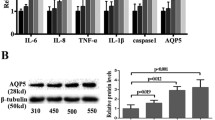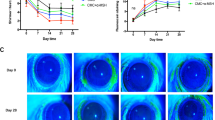Abstract
Tear hyperosmolarity is a key event in dry eye. In this work, we analyzed whether hyperosmolar challenge induces ATP release on the ocular surface. Moreover, as extracellular ATP can activate P2X7 receptor, the changes in P2X7 protein levels and its involvement in pathological process triggered by hypertonic treatment were also examined. High-performance liquid chromatography analysis revealed that ATP levels significantly increased in human corneal and conjunctival epithelial cells exposed to hyperosmotic challenge as well as in dry eye patients as compared to control subjects. A significant reduction in cell viability was detected after hyperosmolar treatment, indicating that the rise in ATP release was mainly due to cell lysis/death. Additionally, vesicular nucleotide transporter was identified in both cell lines and their protein expression was upregulated in hypertonic media. P2X7 receptor truncated form together with the full-length form was identified in both cell lines, and experiments using specific antagonist and agonist for P2X7 indicated that this receptor did not mediate cell death induced by hyperosmolar stress. In conclusion, hyperosmotic stress induces ATP release. Extracellular ATP can activate P2X7 receptor leading to cytotoxicity in many cells/tissues; however, this does not occur in human corneal and conjunctival epithelial cells. In these cells, the presence of P2X7 receptor truncated form together with the full-length form hinders a P2X7 apoptotic behavior on the ocular surface.






Similar content being viewed by others
References
Baudouin C, Aragona P, Messmer EM, Tomlinson A, Calonge M, Boboridis KG, Akova YA, Geerling G, Labetoulle M, Rolando M (2013) Role of hyperosmolarity in the pathogenesis and management of dry eye disease: proceedings of the OCEAN group meeting. Ocul Surf 11:246–258
Chen M, Hu DN, Pan Z, Lu CW, Xue CY, Aass I (2010) Curcumin protects against hyperosmoticity-induced IL-1beta elevation in human corneal epithelial cell via MAPK pathways. Exp Eye Res 90:437–443
Corrales RM, Luo L, Chang EY, Pflugfelder SC (2008) Effects of osmoprotectants on hyperosmolar stress in cultured human corneal epithelial cells. Cornea 27:574–579
Luo L, Li DQ, Pflugfelder SC (2007) Hyperosmolarity-induced apoptosis in human corneal epithelial cells is mediated by cytochrome c and MAPK pathways. Cornea 26:452–460
Zimmermann H, Zebisch M, Strater N (2012) Cellular function and molecular structure of ecto-nucleotidases. Purinergic Signal 8:437–502
Eldred JA, Sanderson J, Wormstone M, Reddan JR, Duncan G (2003) Stress-induced ATP release from and growth modulation of human lens and retinal pigment epithelial cells. Biochem Soc Trans 31:1213–1215
Li A, Banerjee J, Leung CT, Peterson-Yantorno K, Stamer WD, Civan MM (2011) Mechanisms of ATP release, the enabling step in purinergic dynamics. Cell Physiol Biochem 28:1135–1144
Li A, Leung CT, Peterson-Yantorno K, Mitchell CH, Civan MM (2010) Pathways for ATP release by bovine ciliary epithelial cells, the initial step in purinergic regulation of aqueous humor inflow. Am J Physiol Cell Physiol 299:C1308–C1317
Luna C, Li G, Qiu J, Challa P, Epstein DL, Gonzalez P (2009) Extracellular release of ATP mediated by cyclic mechanical stress leads to mobilization of AA in trabecular meshwork cells. Invest Ophthalmol Vis Sci 50:5805–5810
Shahidullah M, Mandal A, Beimgraben C, Delamere NA (2012) Hyposmotic stress causes ATP release and stimulates Na, K-ATPase activity in porcine lens. J Cell Physiol 227:1428–1437
Srinivas SP, Mutharasan R, Fleiszig S (2002) Shear-induced ATP release by cultured rabbit corneal epithelial cells. Adv Exp Med Biol 506:677–685
Lazarowski ER (2012) Vesicular and conductive mechanisms of nucleotide release. Purinergic Signal 8:359–373
Sawada K, Echigo N, Juge N, Miyaji T, Otsuka M, Omote H, Yamamoto A, Moriyama Y (2008) Identification of a vesicular nucleotide transporter. Proc Natl Acad Sci U S A 105:5683–5686
Geisler JC, Corbin KL, Li Q, Feranchak AP, Nunemaker CS, Li C (2013) Vesicular nucleotide transporter-mediated ATP release regulates insulin secretion. Endocrinology 154:675–684
Iwatsuki K, Ichikawa R, Hiasa M, Moriyama Y, Torii K, Uneyama H (2009) Identification of the vesicular nucleotide transporter (VNUT) in taste cells. Biochem Biophys Res Commun 388:1–5
Sathe MN, Woo K, Kresge C, Bugde A, Luby-Phelps K, Lewis MA, Feranchak AP (2011) Regulation of purinergic signaling in biliary epithelial cells by exocytosis of SLC17A9-dependent ATP-enriched vesicles. J Biol Chem 286:25363–25376
Sesma JI, Kreda SM, Okada SF, van Heusden C, Moussa L, Jones LC, O'Neal WK, Togawa N, Hiasa M, Moriyama Y, Lazarowski ER (2013) Vesicular nucleotide transporter regulates the nucleotide content in airway epithelial mucin granules. Am J Physiol Cell Physiol 304:C976–C984
Takai E, Tsukimoto M, Harada H, Sawada K, Moriyama Y, Kojima S (2012) Autocrine regulation of TGF-beta1-induced cell migration by exocytosis of ATP and activation of P2 receptors in human lung cancer cells. J Cell Sci 125:5051–5060
Tokunaga A, Tsukimoto M, Harada H, Moriyama Y, Kojima S (2010) Involvement of SLC17A9-dependent vesicular exocytosis in the mechanism of ATP release during T cell activation. J Biol Chem 285:17406–17416
Nicke A (2008) Homotrimeric complexes are the dominant assembly state of native P2X7 subunits. Biochem Biophys Res Commun 377:803–808
Di Virgilio F, Ferrari D, Adinolfi E (2009) P2X(7): a growth-promoting receptor-implications for cancer. Purinergic Signal 5:251–256
Dutot M, Liang H, Pauloin T, Brignole-Baudouin F, Baudouin C, Warnet JM, Rat P (2008) Effects of toxic cellular stresses and divalent cations on the human P2X7 cell death receptor. Mol Vis 14:889–897
Dutot M, Warnet JM, Baudouin C, Rat P (2008) Cytotoxicity of contact lens multipurpose solutions: role of oxidative stress, mitochondrial activity and P2X7 cell death receptor activation. Eur J Pharm Sci 33:138–145
Minns MS, Teicher G, Rich CB, Trinkaus-Randall V (2016) Purinoreceptor P2X7 regulation of Ca(2+) mobilization and cytoskeletal rearrangement is required for corneal reepithelialization after injury. Am J Pathol 186:285–296
Mankus C, Chi C, Rich C, Ren R, Trinkaus-Randall V (2012) The P2X(7) receptor regulates proteoglycan expression in the corneal stroma. Mol Vis 18:128–138
Mayo C, Ren R, Rich C, Stepp MA, Trinkaus-Randall V (2008) Regulation by P2X7: epithelial migration and stromal organization in the cornea. Invest Ophthalmol Vis Sci 49:4384–4391
McMonnies C, Ho A, Wakefield D (1998) Optimum dry eye classification using questionnaire responses. Adv Exp Med Biol 438:835–838
Gipson IK, Spurr-Michaud S, Argueso P, Tisdale A, Ng TF, Russo CL (2003) Mucin gene expression in immortalized human corneal-limbal and conjunctival epithelial cell lines. Invest Ophthalmol Vis Sci 44:2496–2506
Pflugfelder SC (2011) Tear dysfunction and the cornea: LXVIII Edward Jackson Memorial Lecture. Am J Ophthalmol 152(900–909):e901
Guzman-Aranguez A, Calvo P, Ropero I, Pintor J (2014) In vitro effects of preserved and unpreserved anti-allergic drugs on human corneal epithelial cells. Journal of ocular pharmacology and therapeutics : the official journal of the Association for Ocular Pharmacology and Therapeutics 30:790–798
Feng YH, Li X, Wang L, Zhou L, Gorodeski GI (2006) A truncated P2X7 receptor variant (P2X7-j) endogenously expressed in cervical cancer cells antagonizes the full-length P2X7 receptor through hetero-oligomerization. J Biol Chem 281:17228–17237
Mankus C, Rich C, Minns M, Trinkaus-Randall V (2011) Corneal epithelium expresses a variant of P2X(7) receptor in health and disease. PLoS One 6:e28541
Guzman-Aranguez A, Santano C, Martin-Gil A, Fonseca B, Pintor J (2013) Nucleotides in the eye: focus on functional aspects and therapeutic perspectives. J Pharmacol Exp Ther 345:331–341
Tsubota K, Hata S, Okusawa Y, Egami F, Ohtsuki T, Nakamori K (1996) Quantitative videographic analysis of blinking in normal subjects and patients with dry eye. Arch Ophthalmol 114:715–720
Wang Q, Wang L, Feng YH, Li X, Zeng R, Gorodeski GI (2004) P2X7 receptor-mediated apoptosis of human cervical epithelial cells. Am J Physiol Cell Physiol 287:C1349–C1358
Takai E, Tsukimoto M, Harada H, Kojima S (2014) Autocrine signaling via release of ATP and activation of P2X7 receptor influences motile activity of human lung cancer cells. Purinergic Signal 10:487–497
Feng YH, Li X, Zeng R, Gorodeski GI (2006) Endogenously expressed truncated P2X7 receptor lacking the C-terminus is preferentially upregulated in epithelial cancer cells and fails to mediate ligand-induced pore formation and apoptosis. Nucleosides Nucleotides Nucleic Acids 25:1271–1276
Acknowledgments
We thank Dr. Ilene Gipson, Schepens Eye Research Institute, Massachusetts Eye and Ear, Harvard Medical School, Boston, MA, USA, for providing the HCLE cells. We are grateful to Leyre Nieto Roldan for her technical assistance. This work was supported by the Spanish Ministry of Economy (SAF2013-44416-R, SAF2016-77084R) and the Institute Carlos III (RETICS RD12/0034/0003, RD16/0008/0017).
Author information
Authors and Affiliations
Corresponding author
Ethics declarations
Conflict of interest
Ana Guzman-Aranguez declares that she has no conflict of interest.
María J. Pérez de Lara declares that she has no conflict of interest.
Jesús Pintor declares that he has no conflict of interest.
Ethical approval
This study was performed according to the Declaration of Helsinki. An informed consent was obtained from all participants and they were free to give up the session at any time.
Rights and permissions
About this article
Cite this article
Guzman-Aranguez, A., Pérez de Lara, M.J. & Pintor, J. Hyperosmotic stress induces ATP release and changes in P2X7 receptor levels in human corneal and conjunctival epithelial cells. Purinergic Signalling 13, 249–258 (2017). https://doi.org/10.1007/s11302-017-9556-5
Received:
Accepted:
Published:
Issue Date:
DOI: https://doi.org/10.1007/s11302-017-9556-5




